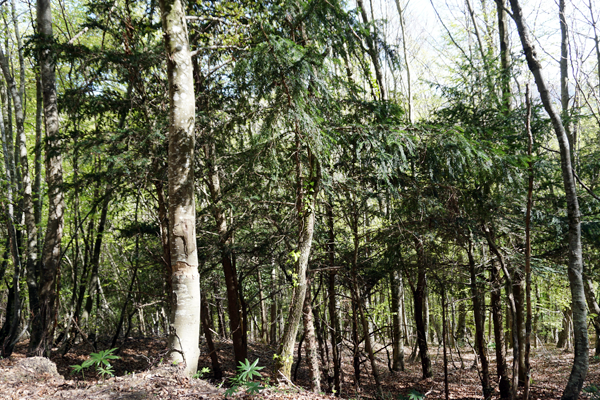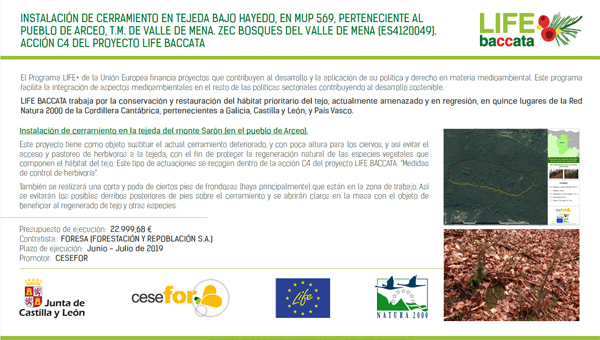The collaboration between the Region Castilla y León, the Cesefor Foundation and the European Commission allows the protection of Burgos' yew woods
28-07-2020

With the aim of contributing to the conservation of the yew forests in the Cantabrian Mountains, the LIFE project "Conserving and restoring the yew forests in the Cantabrian Mountains" (LIFE BACCATA) has been launched.
The LIFE BACCATA project is co-financed by the European Commission within the framework of the LIFE Call for Proposals and is being developed between 2016 and 2020 in fifteen sites of the Natura 2000 Network in the Cantabrian Mountain Range, Galicia, Castilla y Leon and the Pais Vasco. The University of Santiago de Compostela participates as coordinator of the project and the Region Castilla y León, Cesefor, Fundación Hazi and Grupo TRAGSA as partners.

Within the community of Castilla y León, the Region Castilla y León and the Cesefor Foundation have developed the tasks of study and inventory of several of the most important yew woods and now they are developing actions to improve the habitat in the provinces of León, Palencia and Burgos.
The province of Burgos, due to its biophysical, biogeographical and ecological conditions, presents a great potential for the habitat of the yew tree. Thus, we can find yew trees under beech, oak, pine, gall oak and holm oak forests, etc.
 The yew woods of the Special Conservation Area (SCA) "Bosques del Valle de Mena" are located on softened reliefs at a significantly lower altitude than the rest of the Cantabrian roof tiles in Castilla yLeon (from 676 to 439 meters above sea level). Within the Life Baccata Project, whose objective is to improve the state of conservation of the Cantabrian mountain yew woods, three of them have been characterized. It was decided to intervene for this purpose in the Tejeda de Sarón, belonging to the town of Arceo.
The yew woods of the Special Conservation Area (SCA) "Bosques del Valle de Mena" are located on softened reliefs at a significantly lower altitude than the rest of the Cantabrian roof tiles in Castilla yLeon (from 676 to 439 meters above sea level). Within the Life Baccata Project, whose objective is to improve the state of conservation of the Cantabrian mountain yew woods, three of them have been characterized. It was decided to intervene for this purpose in the Tejeda de Sarón, belonging to the town of Arceo.
The yew woods of Saron is found under a very dense beech canopy, the lower stratum being the yew mass. The thickness of the beech forest has caused the yew to drown and die in several areas, so the regional environmental administration, in order to provide more space for certain yews, has made a ringing in beech trees that are above these feet.
Another reason why yew does not proliferate is the pressure that herbivores exert on its regeneration. Today this pressure is not as evident as it was years ago, since in 2007 an enclosure was installed to protect the yew woods from domestic cattle (1.22 m high approx.), giving good results. Even so, lately you can still see the small yews damaged by herbivores, mainly roe deer and deer. The enclosure is effective for cattle but not for these wild herbivores, which can jump over it (especially deer). In addition, there are areas where the enclosure is sloping due to the repopulation of the land or has fallen due to logging, making it easier for these animals to pass through.
For all these reasons, as part of the Life Baccata project, a hunting enclosure has been installed around the yews in order to protect the regenerated trees from wild herbivores. To this end, the existing enclosure has been increased and replaced by a new one where it was deteriorated. The new enclosure has an average height of 2 metres, which will make it more difficult for the deer to jump over it to feed on the tender shoots and small yew plants, which are very appetizing for ruminants especially in the winter season, when food is most scarce. The activity has been executed by the company FORESA and the work has been completed in September. The promoter of this conservation work and partner in the project, the CESEFOR Foundation, has been assisted, in its direction and coordination, by the Technicians and Environmental Agents of the Espinosa de los Monteros Region, of the Territorial Service of the Environment of the Province of Burgos, Government of Castilla y Leon, also being part of the project team.


The LIFE BACCATA project is co-financed by the European Commission within the framework of the LIFE Call for Proposals and is being developed between 2016 and 2020 in fifteen sites of the Natura 2000 Network in the Cantabrian Mountain Range, Galicia, Castilla y Leon and the Pais Vasco. The University of Santiago de Compostela participates as coordinator of the project and the Region Castilla y León, Cesefor, Fundación Hazi and Grupo TRAGSA as partners.

Within the community of Castilla y León, the Region Castilla y León and the Cesefor Foundation have developed the tasks of study and inventory of several of the most important yew woods and now they are developing actions to improve the habitat in the provinces of León, Palencia and Burgos.
The province of Burgos, due to its biophysical, biogeographical and ecological conditions, presents a great potential for the habitat of the yew tree. Thus, we can find yew trees under beech, oak, pine, gall oak and holm oak forests, etc.
 The yew woods of the Special Conservation Area (SCA) "Bosques del Valle de Mena" are located on softened reliefs at a significantly lower altitude than the rest of the Cantabrian roof tiles in Castilla yLeon (from 676 to 439 meters above sea level). Within the Life Baccata Project, whose objective is to improve the state of conservation of the Cantabrian mountain yew woods, three of them have been characterized. It was decided to intervene for this purpose in the Tejeda de Sarón, belonging to the town of Arceo.
The yew woods of the Special Conservation Area (SCA) "Bosques del Valle de Mena" are located on softened reliefs at a significantly lower altitude than the rest of the Cantabrian roof tiles in Castilla yLeon (from 676 to 439 meters above sea level). Within the Life Baccata Project, whose objective is to improve the state of conservation of the Cantabrian mountain yew woods, three of them have been characterized. It was decided to intervene for this purpose in the Tejeda de Sarón, belonging to the town of Arceo.The yew woods of Saron is found under a very dense beech canopy, the lower stratum being the yew mass. The thickness of the beech forest has caused the yew to drown and die in several areas, so the regional environmental administration, in order to provide more space for certain yews, has made a ringing in beech trees that are above these feet.
Another reason why yew does not proliferate is the pressure that herbivores exert on its regeneration. Today this pressure is not as evident as it was years ago, since in 2007 an enclosure was installed to protect the yew woods from domestic cattle (1.22 m high approx.), giving good results. Even so, lately you can still see the small yews damaged by herbivores, mainly roe deer and deer. The enclosure is effective for cattle but not for these wild herbivores, which can jump over it (especially deer). In addition, there are areas where the enclosure is sloping due to the repopulation of the land or has fallen due to logging, making it easier for these animals to pass through.
For all these reasons, as part of the Life Baccata project, a hunting enclosure has been installed around the yews in order to protect the regenerated trees from wild herbivores. To this end, the existing enclosure has been increased and replaced by a new one where it was deteriorated. The new enclosure has an average height of 2 metres, which will make it more difficult for the deer to jump over it to feed on the tender shoots and small yew plants, which are very appetizing for ruminants especially in the winter season, when food is most scarce. The activity has been executed by the company FORESA and the work has been completed in September. The promoter of this conservation work and partner in the project, the CESEFOR Foundation, has been assisted, in its direction and coordination, by the Technicians and Environmental Agents of the Espinosa de los Monteros Region, of the Territorial Service of the Environment of the Province of Burgos, Government of Castilla y Leon, also being part of the project team.


In addition to the installation of the enclosure on the Arceo yew wood, within the province of Burgos, an Arboretum will be built in the Ojo Guareña Natural Monument to promote knowledge about the species that make up the habitat of the yew tree and to disseminate the challenges faced by this species in recent years with regard to its conservation, as well as contributing to the perpetuation of genetic resources.
Other work to be done in the province will be small repopulations between existing yew woods to promote habitat connectivity. This action is based on the implementation of forests that will allow, in the medium/long term, communication between the yew population centres, fulfilling a function as a corridor.
Other work to be done in the province will be small repopulations between existing yew woods to promote habitat connectivity. This action is based on the implementation of forests that will allow, in the medium/long term, communication between the yew population centres, fulfilling a function as a corridor.



